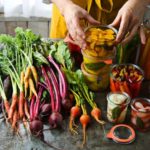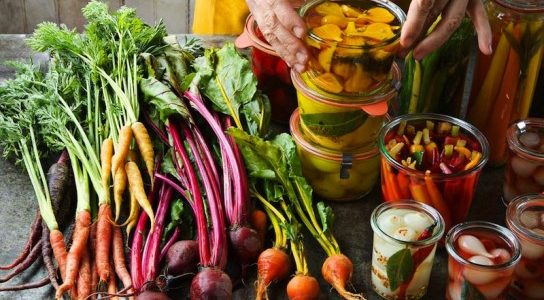Healthy Eating for Fall
 Sure, we all get excited for summer’s bounty of sweet berries and juicy watermelon, but there’s more to fall than Halloween costumes and hay rides. From September to November, the autumn harvest brings a variety of healthful and delicious produce, from squash and sweet potatoes to apples and pears.
Sure, we all get excited for summer’s bounty of sweet berries and juicy watermelon, but there’s more to fall than Halloween costumes and hay rides. From September to November, the autumn harvest brings a variety of healthful and delicious produce, from squash and sweet potatoes to apples and pears.
While almost all produce can be grown somewhere year-round, trucking produce across the country (or across the world) isn’t easy. Buying local seasonal produce not only potentially reduces our carbon footprint and helps local economies, but it may also result in more nutritious produce.
So why not dig into fall fruits like apples and cranberries, which offer essential vitamins and
antioxidants that slow aging and may help fight cancer? On the veggie side, the entire cruciferous
family-that’s the cabbage, rutabaga, and cauliflower gang-is in season and offers a compound known
as glucosinolates that may also have cancer-fighting potential. And who could forget about squash?
These big, bright gourds offer healthy alpha- and beta-carotene, which promote good eyesight.
To get the best of what fall has to offer, check out top autumnal produce picks from Kelly Fitzpatrick at www.greatist.com that are both delicious and super healthy, and keep track of what’s in season near you. Also don’t be afraid to try something new. (Who knew leeks or figs would taste so good?)
Apples
These sweet, crunchy fall favorites are packed with antioxidants, which may help prevent chronic
illness and slow aging. Among popular apple varieties (and there are more than 7,500 different types!),
Fuji apples have the highest concentration of phenolics and flavonoids, while Cortland and Empire
apples have the lowest. Quince, a floral-flavored cousin of the apple, is also at its best in autumn and
can be added to jams, jellies, and desserts-but it is inedible raw.
Beets
They may be available year-round, but beets are at their best in the fall. Besides the familiar reddish purple color, you can also find golden, white, and even multicolored beets. When shopping, look for firm, smooth bulbs and (if attached) bright, crisp greens. Toss the greens in salads and roast the beets for their betaine-a compound that may help prevent heart and liver disease-and nitrate, which may
increase blood flow to the brain and potentially reduce risk of dementia.
Brussels Sprouts and Cabbage
Packed with vitamins A and C, cabbage and its mini-me, Brussels sprouts, boast high concentrations
of cancer-fighting glucosinolates (which also lend these veggies their distinct flavor). Try this easy
Brussels sprouts scramble for a savory start to your day.
Cranberries
Between the size of a blueberry and a grape, cranberries taste their best October through November,
though only 5 percent actually make it to the fresh produce section (the other 95 percent are dried,
canned, or turned into juice). Research suggests cranberry concentrate can help prevent urinary tract
infections and that fresh cranberries can help prevent oral diseases and slow the growth of cancer.
Pears
These sweet fruits fall into two major categories: European and Asian. The European varieties, Bosc
and Bartlett, are most common, and grow on the west coast during fall. Pears are high in soluble fiber,
which helps lower “bad” (LDL) cholesterol. To get that daily dose of fiber and to satisfy a sweet tooth,
snack on the fruit whole or incorporate into recipes from filling breakfasts to healthier cocktails.
Pomegranates
Held sacred by many ancient religions, pomegranates have health benefits that have only been
recognized more recently (POM juice, anyone?). While much of the research has been inconclusive,
some studies suggest the fruit’s antioxidants may reduce the risk of cardiovascular complications like
heart attacks. Early studies also suggest that pomegranate may help prevent breast and colon
cancers, though results are far from conclusive. These labor-intensive fruits can be a hassle to deseed,
but we figured out the best way to do so. Ah, victory is sweet.
Pumpkins
Though technically a member of the squash family, with their rich history and health benefits (plus their
essential role in Halloween festivities), pumpkins earn their own spot on our list. Pumpkin is one of the
best sources of alpha- and beta-carotene, which can be converted into retinol to promote healthy vision
and cell growth. Pumpkin seeds are also a good source of alpha-linolenic acid, an omega-3 fatty acid
that may help those with heart disease, high blood pressure, or high cholesterol. Toast them up for a
deliciously nostalgic treat!
Rutabagas and Turnips
These root veggies aren’t winning any beauty pageants with their bulbous shape and occasionally hairlike roots, but what they lack in looks they make up for in nutrition. Research suggests eating turnips
and rutabagas may help reduce the risk of prostate and lung cancers. What’s more, turnip greens are
a source of calcium, and one cup of raw rutabaga offers a respectable three grams of fiber.
Squash
Squash is the poster food for autumn. Summer squash are still available locally until October in some
parts of the country, and winter squash begin to crop up (pun intended) as summer squash heads out.
The gourd family offers varieties including acorn, butternut, and delicata squash, as well as spaghetti
squash and its pasta-like strands.
Sweet Potatoes
These orange beauties have the best flavor during fall, their peak season. Like squash, sweet potatoes
are rich in beta-carotene, which can prevent vitamin A deficiencies, promote healthy eyesight and
generate retinol production. Sweet potatoes are also a good source of vitamin C, and when eaten with
their skin on, a medium tater can pack nearly four grams of fiber.
Enjoy Fall’s bounty, happy eating!



Comments are closed.